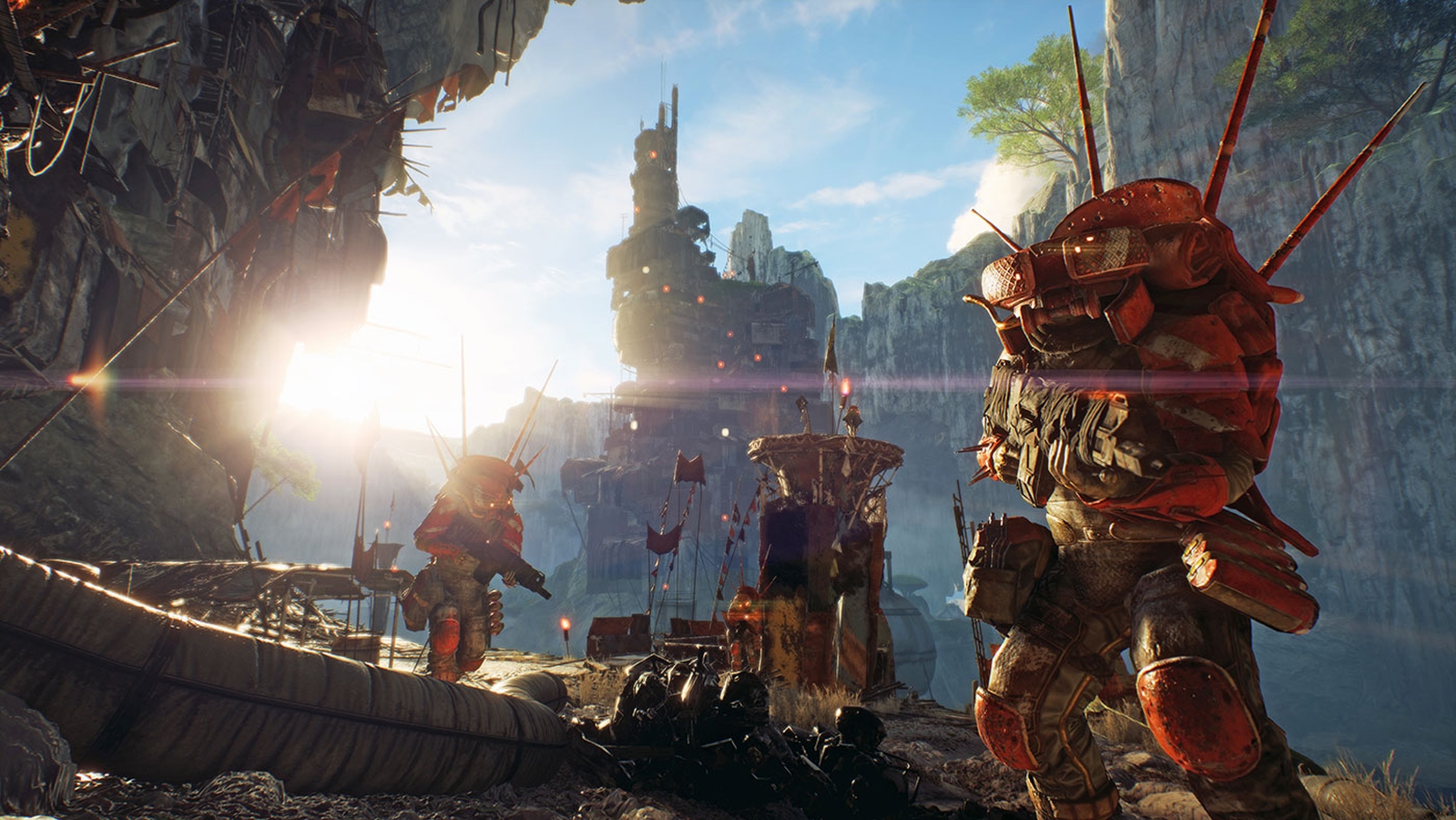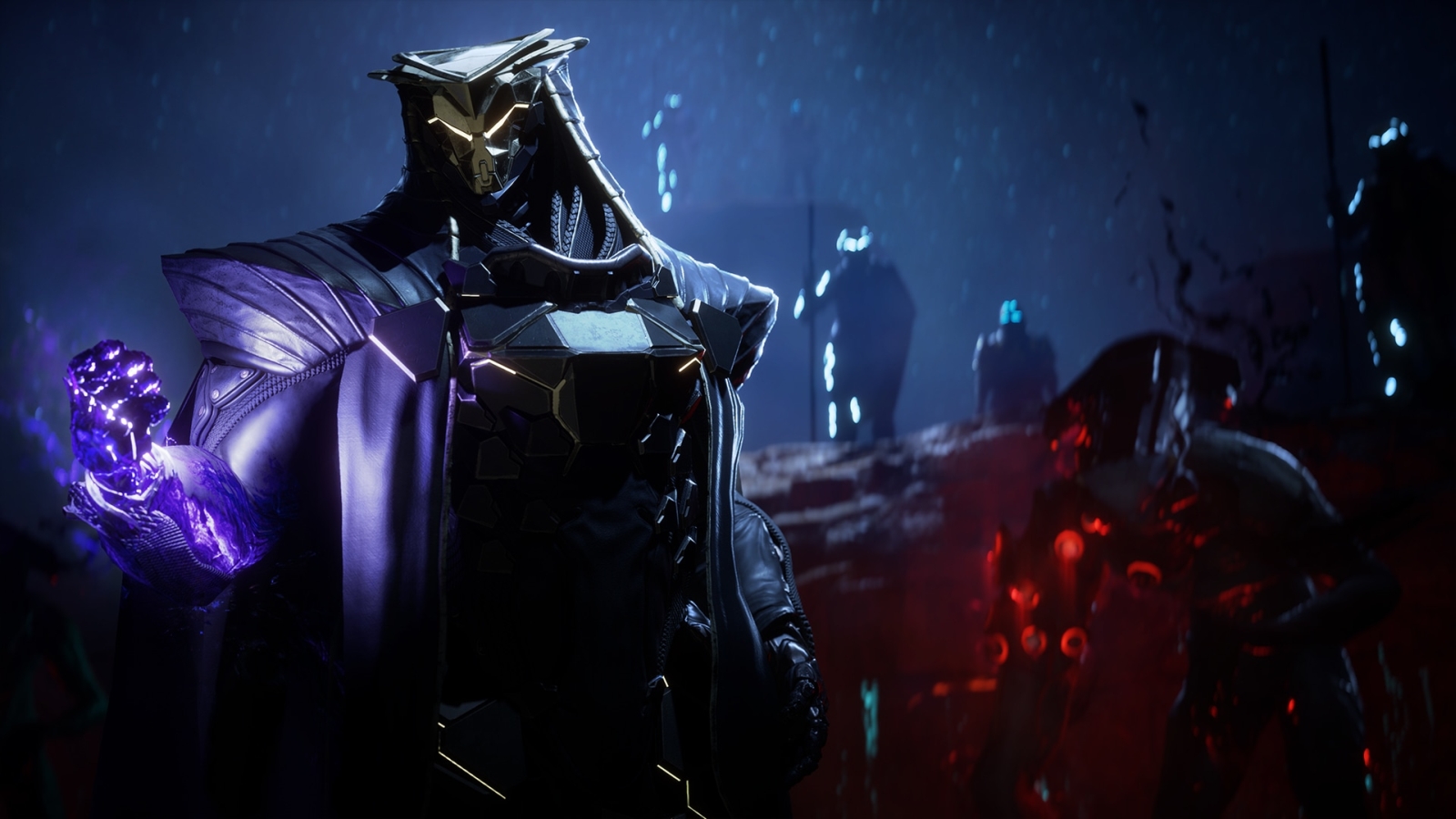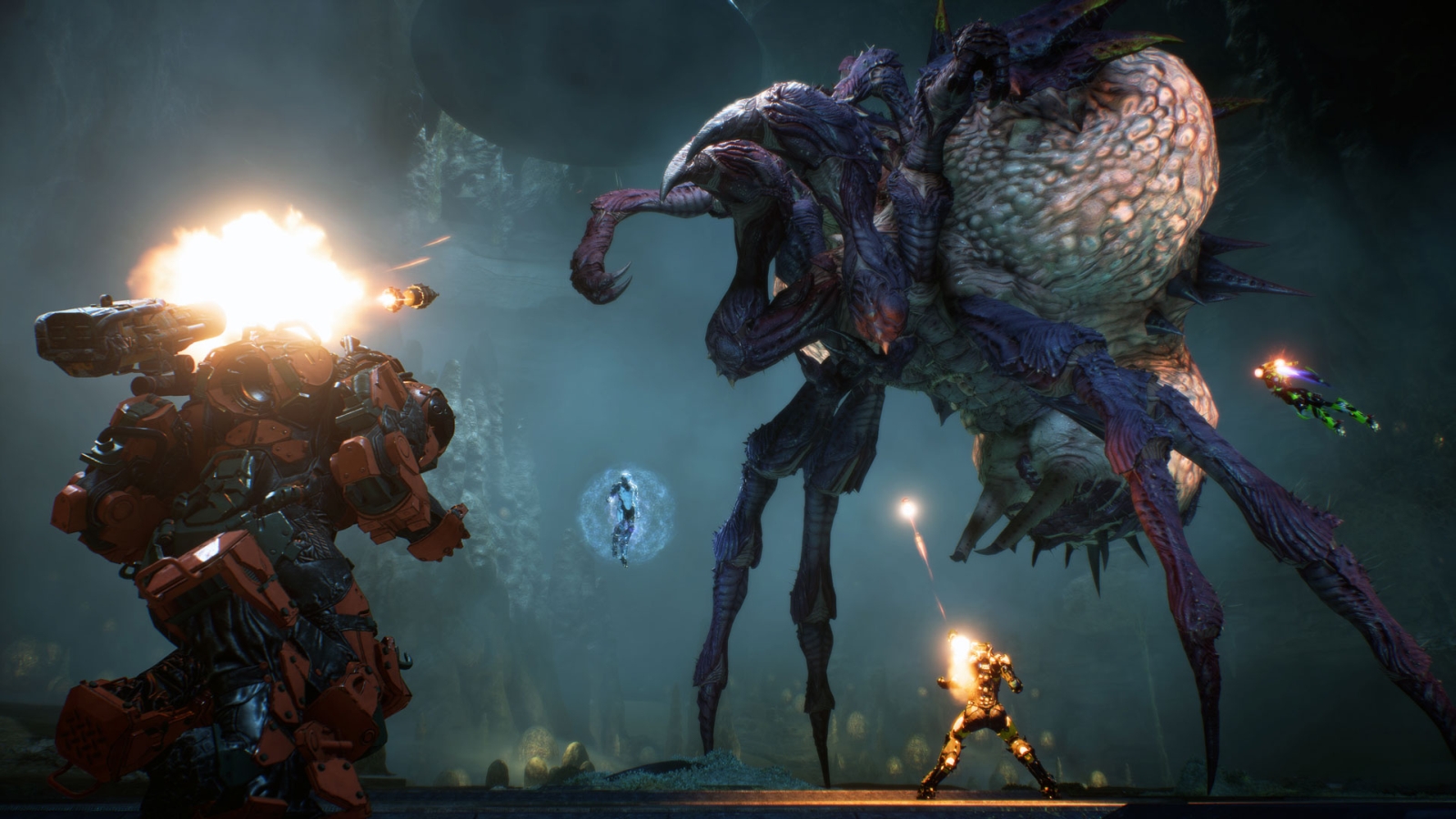Before we get into the review proper, I have a bit of a caveat and a comparison to make that will explain while any review of this game is essentially a Javelin in motion. As Anthem is an always-connected world and is capable of injecting world events without patches, the team at Bioware is able to drastically change the nature of the game at will. This review, like any other from the launch period of the game, is a single moment in time. As the expressed roadmap is realized, much of what we see today could be vastly different. We saw this with other games like The Division, Diablo III, the Destiny series, and Warframe that were vastly improved over time. As a result, we’ll periodically revisit our assessment of Anthem with reviews and impressions of the game’s state as the live service unfolds.
Bioware, the makers of rich and expansive epic role playing games like the Baldur’s Gate, Neverwinter Nights, Dragon Age, Mass Effect, and Knights of the Old Republic series of games wants to try something a little bit different. While the Mass Effect games dabbled in the shooter world with its intense and successful campaign and multiplayer, for Anthem it was time to throw in full tilt. A rocket-powered class-based looter-shooter at its heart, Anthem represents Bioware’s attempts to fuse the two worlds together, with a dash of their signature storytelling style.
For RPG players like myself, the big question I had with Anthem going in was whether or not it was going to deliver the incredible stories and character interactions we’ve come to expect from the Bioware team. While I can say that I’m thoroughly enjoying the story, I can’t help but be a bit disappointed at the further reduction of choice in the game, at least in terms of storyline. When you encounter conversation options, they are reduced to just two choices. While they do result in a different voice line, they are most commonly used to increase standing with the different factions in the game — I’ve not seen anything that I’d classify as a drastic change based on these ultimately binary choices. In that way, Anthem feels very linear by way of comparison. That said, it is no less impactful, full of surprises, and has characters that you’ll truly enjoy over the course of the game.

The world of Anthem is filled with interesting characters.
The four Javelins currently available (there is absolutely nothing preventing the team from adding additional suits in the future) are the Ranger, Interceptor, Colossus, and Storm. The Ranger is a good all-around suit, capable of delivering solid damage with a variety of firearms, as well as launching missiles with a shoulder-mounted cannon. It’s not the fastest, or the most powerful, but it is the only Javelin capable of launching its ultimate ability while in flight. The Storm is a caster class, delivering devastating elemental attacks like fire, ice, and lightning. While it can use the same firepower as the Ranger, it has less armor. That said, when the Storm hovers, it powers up its shields, conferring some additional damage and shield power. The Colossus is the heaviest Javelin (the Internet has already dubbed it “Thicc boi”), and the only one capable of utilizing the heavy mortar launcher, rotary cannon, and flamethrower. What it lacks in mobility and the loss of energy shields, it makes up for in a heavy smash attack and a massive steel plate shield that lets it run through foes, bashing them to the ground. The fourth Javelin is the Interceptor. As its name suggests, it is the fastest of the Javelins, capable of chaining dodges together, leaping into danger to deliver devastating melee strikes, and then zipping away before the enemy can react. This is important as the Javelin has the smallest pool of armor and shields. That said, it’s also the only Javelin that becomes completely invulnerable when unleashing its powerful melee-based ultimate.
What makes Anthem interesting is that all of the descriptions of the Javelins above are as right as they are wrong. By changing out parts on your Interceptor, it can go from delivering a powerful dash attack to flinging glaives from midrange, changing its role entirely. Similarly, the Storm can unleash attacks that can freeze foes for AoE-based crowd control, or they can charge up powers for a single powerful attack. The Colossus can be a close-up tank, utilizing their shield to mow down enemies, or can hang in the back to launch artillery from a safe distance. The Ranger is capable at nearly any distance, but just like the others, it’s all about choice and how you have equipped your Javelin. It’s this flexibility and nuance that I think makes the game incredibly fun with any suit you’ve unlocked. The fact that these are spaced out at levels 2, 8, 16, and 26 encourages you to learn each of them over time so as to not overwhelm you with too much too early.

You can customize your Javelin any way you’d like, but so many end up looking like Iron Man.
Beyond leveling, there are multiple difficulty levels available for every mission — six in fact. The first three, easy, normal, and hard, are selectable from level 1 to level 29. Easy provides little challenge, but is a good place for shooter-rookies, or people who want to just experience the story aspects of Anthem. Normal bumps the difficulty a little bit, offering a small boost to XP and loot. Hard raises enemy damage and health by another 50%, but rewards players with some additional loot drops for the effort. Once you hit level 30, you’ll unlock another three difficulty levels entitled Grandmaster 1, 2, and 3. The Grandmaster levels, not unlike the additional difficulty settings in games like Diablo III, are your path to greater rewards for greater risk, requiring a high degree of team coordination and a thorough understanding of your Javelin build.
As this is a looter-shooter, naturally there are six classifications of loot from Common to Legendary, with more rare objects carrying supporting “inscriptions” granting additional power augmentations like damage, speed, shields, elemental attacks, or more exotic examples like recharging shields upon reload. If you are familiar with the “Ancient items” system from Diablo III, you’ve got the right idea. As you might expect, you’ll pick these up from chests and slain enemies, but there is also a full crafting engine to augment your loot drops. Flying around the world reveals organic and mineral materials called Chimeric Alloys and Compounds, as well as weapon parts, embers, and items specific to each Javelin type. Once you have the requisite materials, you’ll probably want to do something with them, and that requires blueprints. Blueprints are unlocked in a variety of ways depending on what you are trying to build. You can craft Common gear almost as soon as you reach Fort Tarsis post-tutorial, but getting higher rarity blueprints means completing challenges. Weapon blueprints are often rewarded for performing specific actions such as scoring headshots with the rarity tier below it, or dispatching a number of foes with the weapon. Individual components are divided up with two slots for offensive gear, one slot for support, six component slots, two weapons, and your ultimate ability, all gated by level and unlocked over time. These items are tied to faction loyalties.

Not all factions are friendly. Behold the Scar.
There are several friendly factions around Fort Tarsis, and all of them would like the help of a Freelancer like you. Having conversations with the various NPCs in Fort Tarsis will yield missions, and completing them will provide a bit of improvement to your relations with that group. Faction levels might erect a statue in the city, access to a new store, or even new blueprints for gear. This encourages the player to interact within the city and explore the storyline.
While I can’t speak to the performance of the console versions, the PC has seen some drastic improvements over the last 15 days. The VIP and open demo weekends were plagued by extremely long load times, clunky keyboard/mouse controls, variable framerates, and an extensive list of bugs including incomplete loading, Javelins without heads, and overall stability. I’m happy to say that I’ve seen absolutely none of these issues since the day 1 patch. Better still, the game can now run on Ultra settings on my EON-15X from May of 2015 with it’s GeForce 980m (a desktop 770 equivalent) and still maintain a 45 fps framerate. A few tweaks put it at 1080p/60, but it just goes to show how much work went into the final patch and the driver updates from NVIDIA as this laptop was sub-30 fps prior. Naturally, a 1080TI card is able to deliver 4K/60, but it seems that Anthem will look great and run like a top on any reasonably-powered PC.

The world of Anthem is mysterious.
If I had a wish list item, it would be cross-play. Given how much of the action takes place server-side, this doesn’t sound insurmountable, but Bioware Executive Producer Mark Darrah announced that this will not be available at launch. This leaves the door open for the future, and would give Anthem a vastly-expanded audience.
If I had a serious complaint with Anthem, it’s the limitations of the current mission design. Nearly every mission follows the same pattern with little variance. You’ll set out on a mission, kill enemies in the mission zone to retrieve an object of some sort, defend a signal emitter, kill another wave of enemies and possibly a boss, and then zip back to base to do it all again. The open world mission events have a little more variety, and the Bioware team can change it on the fly, but the already-revealed roadmap will need to have more variety than this.
There is one mission set that I am absolutely mortified made the final cut. Just about the time the story starts to gain traction, the whole process is ground to a complete halt when you are sent to unlock four temples. Rather than following the normal structure defined above, players are asked to grind out a series of challenges like defeating a certain number of foes with their ultimate ability, scoring a specific number of melee attacks, open a number of boxes, and others. There are already several tutorials to help players get through this grind as quickly as possible, but this entire set of missions feels like unnecessary padding at best, and a pointless grind at worst.

Ash Titans serve as a sort of world boss and are always a challenge.
When Anthem works the way Bioware envisioned it to work, the game is an absolute triumph. That said, even post day-1 patch, there are a lot of moments that seem like they could be improved to keep the player immersed in the world they’ve created. Loading screens are frequent, and much of the extended lore is buried in collectable codex elements you’ll discover throughout the game world. While load times have been drastically reduced by the day-1 patch, you’ll likely have the handful of images and tooltips burned into your mind. It’d likely make more sense to strip the oft-repeated Scar warrior / Javelin side profile pictures and replace it with those lore bits to give the player something to do while they wait for the world to load.
Beyond the loading sequences, there are some odd choices with mission structure and mechanics. Pairing up with other players to jump into a mission comes to an abrupt end after completion, zipping them back to Fort Tarsis — there is currently no mechanism to jump to another mission with your friends without essentially restarting. Similarly, some missions can be played privately (meaning the game doesn’t pair you up with randoms, letting you set out with less than four players, or even solo) whereas others can only be run in Freeplay. Freeplay allows you to set out to explore outside of the confines of a prescribed mission, letting you stumble onto world events, hunt down crafting materials, and exploring the aforementioned lore elements.

Calm, cool, collected, and inexorably driven to destroy you — say hello to The Monitor.
Beyond mission design, there is a great deal of work to be done on the user interface and experience. While there has been a great deal of improvements made over the last month, the menus are still overbuilt and clearly designed for consoles, requiring long presses on items that would otherwise be a simple clickable object. Similarly, things like tracking missions on screen are missing, requiring the player to stop and navigate through several menu tabs to look at status. There is also no way to place a waypoint on the map, signal to your team that you are down if you aren’t using voice chat, no text-based chat, a more thorough description of some of the mechanics and powers, and other similar quality-of-life items you’d expect in a multiplayer game.
You’ll notice that nowhere in this review did I say anything negative about the combat. The reason is simple — the Bioware team has absolutely nailed that aspect of the game. Everything from the three-point hero stance landing emote you start off with, to the big flip and rocket launched takeoff of the lithe Interceptor javelin makes you feel like an absolute badass superhero. Better still, every Javelin feels completely different and viable in their own way. While the enemy variety is a bit thin, it never gets old roaring into their midst and tearing them apart with speed and verve.

There are (currently) three “Raid”-esque Strongholds to tackle, with more on the way.
Given that Anthem is an online service, there is obviously concern about loot boxes. Thankfully, the loot boxes in Anthem are entirely cosmetic. You can certainly buy coins and craft weapons with them, but they give you no distinct advantage as the game is a non-competitive experience, and everything can be easily earned via completing in-game objectives. The store features a wide variety of different looks for your Javelin, as well as emotes and other fun cosmetics, but there’s little to be concerned about.
While I’ve had plenty of suggestions for improvement in this review, I will enthusiastically say that it’s easily some of the most fun I’ve had with a looter-shooter in recent memory. This enjoyment multiplies exponentially when teamed up with other players, and even more so when everyone is on comms and working together. Watching the Bioware team engage with their audience directly via social media, and their willingness to adjust and flex their game’s vision to make it more compelling and enjoyable is inspiring. Just over the past two weeks over 100 improvements have been made to the engine, gameplay, the UI, and performance, giving us a glimpse into the passion Bioware has for their new universe. If this is what Bioware has in store for Anthem, I’m 100% onboard.

Bonus: This is a Grabbit. They are cute. Don’t shoot them.
Ron Burke is the Editor in Chief for Gaming Trend. Currently living in Fort Worth, Texas, Ron is an old-school gamer who enjoys CRPGs, action/adventure, platformers, music games, and has recently gotten into tabletop gaming.
Ron is also a fourth degree black belt, with a Master's rank in Matsumura Seito Shōrin-ryū, Moo Duk Kwan Tang Soo Do, Universal Tang Soo Do Alliance, and International Tang Soo Do Federation. He also holds ranks in several other styles in his search to be a well-rounded fighter.
Ron has been married to Gaming Trend Editor, Laura Burke, for 28 years. They have three dogs - Pazuzu (Irish Terrier), Atë, and Calliope (both Australian Kelpie/Pit Bull mixes), and an Axolotl named Dagon!

Anthem’s rich storytelling and engaging combat lays the foundation for Bioware’s newest adventure. While there are plenty of quality of life improvements to be made, Anthem’s ambitious approach to the looter-shooter genre is encouraging given the development team’s steadfast community engagement. With a roadmap stretching far into the horizon, we’ll be flying around the world of Anthem for a long time to come.
PROS
- Combat is rewarding and engaging
- Graphically gorgeous with an amazing soundtrack
- Compelling storyline
- Flexible world platform with extensive roadmap
- Heavy developer engagement
CONS
- UX and UI improvements are needed
- Frequent loading sequences
- Mission complexity needs variety
- Some bugs remain

 Buy Now
Buy Now
 Buy Now
Buy Now
 Buy Now
Buy Now
 Buy Now
Buy Now
 Buy Now
Buy Now
 Buy Now
Buy Now















